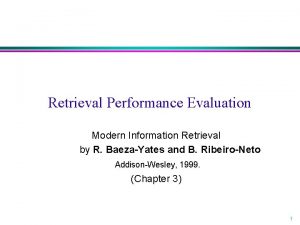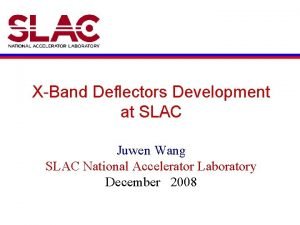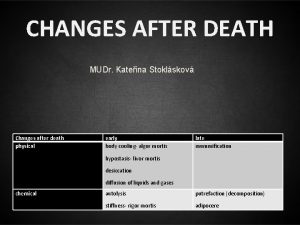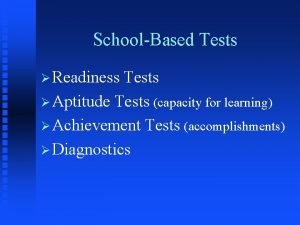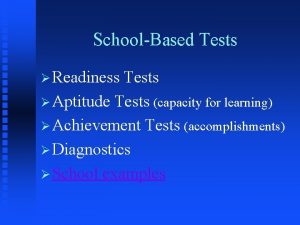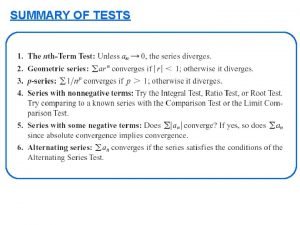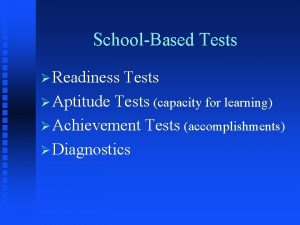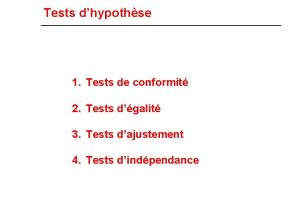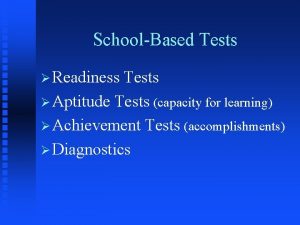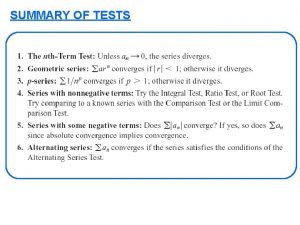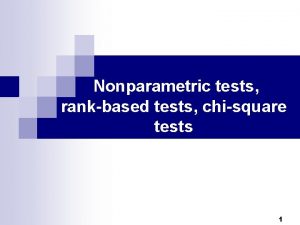Structure Changes after High Power Tests Juwen Wang





















- Slides: 21

Structure Changes after High Power Tests Juwen Wang 5 th X-Band Structure Collaboration Meeting May 18, 2010

T 18 -SLAC #1 High Power Test The following 900 hrs, maximum unloaded gradient is 120 MV/m Short pulse higher gradient condition Pulse shape dependence BKD study. BKD pulse width dependence study at 110 MV/m. BKD gradient dependence study at 230 ns pulse width Faya Wang

Amplitude Measurement of T 18 -SLAC #1 Before and After High Power Test 11421. 7 MHz at 21. 32°C, N 2 Before high Power test 11421. 87 MHz at 20. 4°C, N 2 After high power test

Phase Measurement of T 18 -SLAC #1 Before and After High Power Test 11421. 7 MHz at 21. 32°C, N 2 ore high Power test 11421. 87 MHz at 20. 4°C, N 2 After high power test

Comments on T 18 -SLAC #1 Before and After High Power Test • From the Standing wave pattern, the output part was mismatched, it can be caused due to the “damage” by the high power test of backward feeding in order to compare with single cavity test. • In general, there was no frequency change of 2π/3 mode at similar operation condition. • CERN confirmation done. • The frequency of high power test was ~ 3 MHz higher than the tuned frequency. Because the structure is a nice band-pass filter, the field pattern and S 12 almost no change. Only the mode phase advance was not 2π/3.

Amplitude Measurement of T 18 -KEK Before and After High Power Test 11421. 7 MHz at 21. 1°C, N 2 Before high Power test 11422 MHz at 21. 1°C, N 2 After high power test

Phase Measurement of T 18 -KEK Before and After High Power Test 11421. 7 MHz at 21. 1°C, N 2 Before high Power test Considering the string perturbation and temperature correction, the frequency was increased by 1. 2 MHz (Toshi calculated 1. 1 MHz). 11423. 2 MHz at 22. 7 deg°C in N 2 After high power test

Comments on T 18 -KEK Before and After High Power Test • From the Standing wave pattern, the output part was damaged. • In general, there was a 1 MHz frequency increase of 2π/3 mode at similar operation conditions. In another words, the cumulated phase drift was about 16° at frequency at similar operation conditions. • The total high power test time was 400 hours, is it a reason to cause more “damage” in comparison with T 18 SLAC?

TD 18 -SLAC High Power Test Faya Wang

Phase Measurement of T 18 -KEK Before and After High Power Test 11424. 5 MHz at 21. 46°C, N 2 Before high Power test 11424. 56 MHz at 21. 1°C, N 2 After high power test 16. 5° Select bead pulling frequencies based on the same measurement condition for both before and after high power test

Amplitude Measurement of TD 18 -SLAC Before and After High Power Test 11424. 5 MHz at 21. 46°C, N 2 Before high Power test 11424. 56 MHz at 21. 1°C, N 2 After high power test

Phase Measurement of TD 18 -SLAC Before and After High Power Test 11424. 5 MHz at 21. 46°C, N 2 ore high Power test 11424. 56 MHz at 21. 1°C, N 2 After high power test 16. 5° Select bead pulling frequencies based on the same measurement condition for both before and after high power test

Comments on TD 18 -SLAC Before and After High Power Test • From the Standing wave pattern, the output part was mismatched. • In general, there was a 1 MHz frequency increase of 2π/3 mode at similar operation conditions. In another words, the cumulated phase drift was about 16° at frequency at similar operation conditions • The pulse heating for TD 18 structure is higher, but we believe the “damage” was still in the disc irises. • The total breakdown event recorded was more than 4000 – only twice higher than T 18 SLAC #1, but the TD 18 breakdown rate measured after 700 hours was higher than T 18 SLAC #1 by factor of 100! The “damage” can be caused at higher power and full pulse width in stead of the process beginning with lower power and short pulse width.

Amplitude Measurement of T 18 -SLAC #1 Before and After High Power Test 11424. 1 MHz at 20. 02°C, N 2 Before high Power test 11424. 15 MHz at 20. 4°C, N 2 After high power test

Phase Measurement of T 24 -SLAC Before and After 800 Hours High Power Test 11424. 1 MHz at 21. 1°C, N 2 After high Power test 11424. 1 MHz at 21. 2°C, N 2 Before high power test 6º Select bead pulling frequencies based on the measurement condition to get 2π/3 phase advance for both before and after high power test

Rs reflection phase observed in T 24 -KEK structure • Frequency change +1 MHz. • Body temp change • IQ amplitude dependence << MHz Rs phase 20110108~20110117, pulse width 252 ns; Red point is ACC BD, green is 1 st BD; 2011/2/9 Higo for US-HG 2011 at SLAC Damage through operation if not due to change during vac bake? 16

Comments on T 24 Before and After High Power Test • From the Standing wave pattern, the output part was mismatched. • In general, for SLAC there was a 0. 3 MHz frequency decrease of 2π/3 mode at similar operation conditions. In another words, the cumulated phase drift was about 6° at frequency at similar operation conditions, but different direction. • For KEK flanges structure there was a 1 MHz frequency increase of 2π/3 mode at similar operation conditions. In another words, in the direction like most of structures.

Historical Information for the NLC/GLC Structures in Comparison Before and After High Power Tests <1. 5° H 60 VG 3 R 1000 Hours RF on (65 MV/m, 400 ns) 8000 Body Breakdown <2° H 90 VG 3 N 1600 Hours RF on (65 MV/m, 400 ns) 9500 Body Breakdown <3° T 53 VG 3 MC 900 Hours RF on (92 MV/m. , 400 ns) 1600 Body Breakdown

Integrated Phase Advance (degrees) Bead-Pull Phase Advance Measurements of H 60 VG 3 (FXB 2) Before and After 300 Hours of Processing to 70 MV/m (7000 Breakdowns, 300 Hours RF On) Cell Number

Comments on the History of NLC/GLC Structures Before and After High Power Test • There was no increased Standing wave pattern, the phase plots in output parts were used to fit together in order to compare the phase change before and after high power tests. • In general, there was a no frequency change for designed mode 2π/3 or 5π/6 at similar operation conditions. In another words, the cumulated phase drift for those long structures were very few degrees at frequency at similar operation conditions

Conclusion We need continue to pay close attention on the measurement and analysis the structure status before and after high gradient operation. It always is a critical issue for the life time and stabilization of the high gradient accelerating structures.
 After me after me after me
After me after me after me If any man will come after me
If any man will come after me Iq intelligence
Iq intelligence Changes in latitudes, changes in attitudes meaning
Changes in latitudes, changes in attitudes meaning Physical and chemical changes
Physical and chemical changes Real power and reactive power
Real power and reactive power Animal farm chapter 5 summary
Animal farm chapter 5 summary Post mortem changes
Post mortem changes Casper's dictum
Casper's dictum Uil elementary number sense practice test
Uil elementary number sense practice test Chapter 5 life after high school
Chapter 5 life after high school What's next thinking about life after high school
What's next thinking about life after high school Budgeting for life after high school worksheet
Budgeting for life after high school worksheet When it comes to thinking about life after high school
When it comes to thinking about life after high school What happened after hitler came to power
What happened after hitler came to power Viewer discretion is advised'' warning intro
Viewer discretion is advised'' warning intro High precision vs high recall
High precision vs high recall High precision vs high recall
High precision vs high recall Directive behavior and supportive behavior
Directive behavior and supportive behavior High expectations high support
High expectations high support High precision vs high accuracy
High precision vs high accuracy Directive behavior
Directive behavior
















